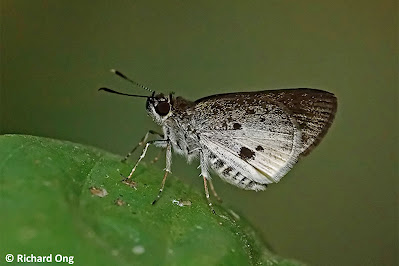The White Palm Bob (Suastus everyx everyx)
A White Palm Bob feeding on bird dropping
We are at the end of the first quarter of the year, and the weather has gone wonky again. Severe floods hit the southern part of the Malay Peninsula in five districts in the state of Johor, where over 5,000 residents were evacuated to flood relief centres. The monsoon surges inundated Singapore too, but the years of upgrading drains, building underground reservoirs and enhancement of flood alleviation infrastructure managed to mitigate the severity of the floods that hit Johor. Yes, there were still some flash floods in Singapore, but those didn't last very long.
March is usually a warm humid month in Southeast Asia, but the weather has been atypically wet over the last two weeks of the month. And as if to remind the human race of Mother Nature's wrath, a 7.7 magnitude earthquake, with its epicentre near Mandalay, hit Myanmar, causing widespread damage and fatalities. A 33-story building under construction near the popular Chatuchak market in Bangkok, Thailand’s capital city, collapsed. Footage of the building’s demise shows crowds of onlookers running away from the rubble in panic.
The aftershock of the Myanmar earthquake could be felt in China and even as far south as Penang in Malaysia where tremors were reported. One wonders if these earthquakes and fault lines that are constantly shifting will one day reach Singapore, and what is needed to plan and design buildings for such an eventuality?
All over the world, the Muslim community celebrates Hari Raya Puasa on 31 Mar 2025, after a month of fasting in the month of Ramadan. Astronomical calculations indicate that the crescent moon for the Islamic month of Syawal appeared above Singapore’s horizon for 48 minutes following sunset on Sunday. The sighting of the crescent moon not only marks the beginning of Syawal but also signifies that Hari Raya Puasa, or Hari Raya Aidilfitri, will take place on 31 March.
Our Butterfly of the Month for March 2025 is the White Palm Bob (Suasus everyx everyx). Only recently discovered, the White Palm Bob is considered a new addition to the Singapore checklist, and hence considered "non-native". It is fast-flying, skittish and frequents the deep-shaded forested nature reserves of Singapore. Described as "very rare" in Malaysia (ref C&P5 pp 315 and Plate 118 : 10), the White Palm Bob is quite regularly observed in Singapore and classified as "Near Threatened" in the Singapore Red Data Book 3rd Edition.
Dorsal view of a White Palm Bob
The White Palm Bob is dark brown above and unmarked except for a narrow whitened area at the tornus of the hindwing. The underside of the hindwing is largely whitened and there is a dark greyish spot at the dorsal area of the hindwing. The hindwing cilia is whitened in pristine individuals. The costal area of the underside of the hindwing appears speckled with white dots on a brownish base.
A White Palm Bob feeding on the flowers of the Red Tree Bush (Leea rubra)
The butterfly usually lurks in shady forested areas where it can be spotted perched on the uppersides of leaves with its wings folded upright. It is also observed puddling at muddy footpaths, feeding on bird droppings and occasionally on the flowers of Leea rubra and Leea indica at forested edges.
The species has been successfully bred in Singapore on Daemonorops augustifolia (Arecaceae) (Water Rattan Palm), a relatively common palm found in the nature reserves. It shares this host plant with at least two other skippers, the Tree Flitter (Hyarotis adrastus praba) and Quedara monteithi monteithi and both species can also be found in the same locations as the White Palm Bob.
Text by Khew SK : Photos by David Ho, Khew SK, Koh CH, Neo TP, Richard Ong, Michael Soh, Horace Tan, Mark Wong, Benjamin Yam and Angela Yeo.












No comments:
Post a Comment